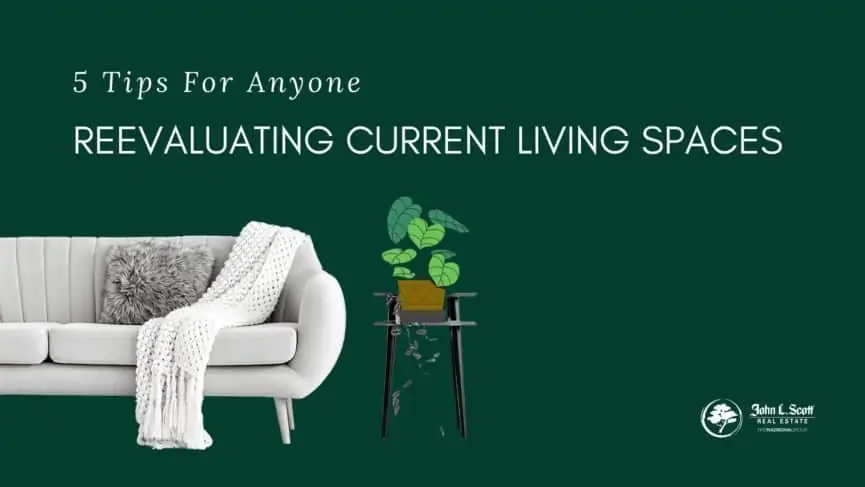This year has forced us to spend more time in our homes than ever before, prompting leaving them Reevaluating Current Living Spaces During COVID-19.
This article will provide anyone who may be Reevaluating Current Living Spaces During COVID-19 in the face of the changing climate with five tips on how to find or make the space they need.Whether you and your family have recently transitioned to remote working and learning, reached a new stage in life, or simply realized you don’t have enough space, there are many reasons why your living accommodations may need to change.
During a time when there are many uncertainties, it may be difficult for you to determine what exactly you may need and how you can satisfy those needs. To help, we’ve rounded up five tips to guide you as you identify your needs and reevaluate your living space:
1. Determine if it’s Better for You to Rent or Own
A wide range of factors are often considered when deciding whether to rent or own a home.
Renting a small apartment may be all you require, especially when financial considerations are taken into account. Renting a home or apartment is still a smart investment as it ensures a roof over your head. In the long-run, however, individuals may actually end up spending more money paying rent than they would in mortgage payments over time.
Renting doesn’t allow you to build equity, but it may make sense if you’re simultaneously paying off high debts, don’t have enough saved for a down payment on a home, or your job requires you to travel.
It may also be ideal if you’re a single young professional who doesn’t necessarily need a whole house to yourself.
On the flip side, buying a home is a more permanent decision that would make sense if you’re looking to:
- Build equity
- Have more privacy
- reap certain tax benefits
It may also be the better option if you have money saved up for a down payment and can afford to invest in a home without putting yourself in a poor financial position.
Even if you don’t have a significant amount saved up for a home, there are many first-time home buyer options available, such as:
- government-backed mortgage
- down payment assistance programs
- qualify for veterans affairs
- federal tax incentives
These options have less stringent requirements for qualification and are designed to lower upfront costs and make homeownership more feasible for first-time buyers and those working with tight budgets.
2. Consider Rightsizing For Your Needs
If your housing needs have changed due to stay-at-home orders, remote work and schooling, or you’ve recently entered a new stage in your life (e.g. a family member leaves for college, you recently had a child, or you’re preparing for retirement), you may be in the perfect place in your life to “rightsize.”
Depending on your circumstances, you might consider increasing or decreasing the size of your living space based on your changing needs. This may mean investing in home additions or moving to a more suitably-sized home altogether.
Downsizing is a popular option for recent retirees and families that have decided they have more living space than necessary. Downsizing your home might lower your living expenses, help you lead a more minimal lifestyle, or reduce your debt. For empty nesters and single individuals alike, the choice to downsize may be a more suitable option during this time, especially if they are planning to retire soon or may require specific accessibility accommodations.
On the other hand, work-from-home arrangements and stay-at-home orders have prompted many homeowners to look for more space. Amid the pandemic, single-family homes in particular have become increasingly popular as buyers seek more square-footage, privacy, and amenities. If several family members are working and/or learning remotely, you may need more space than you currently have available. The extra space that a single-family home would offer could be used for a home office or gym, or just as additional living space while you quarantine at home.
3. Decide if a Relocation is Best
For anyone looking into a new city or state of residence, now may be the right time to take the leap.
Whether your current home is no longer satisfying your needs or you want to relocate from the city-center to a more affordable suburban area, increased remote work policies, flexible housing options, and historically low mortgage rates have allowed individuals to take advantage of the opportunity to move.
In particular, the pandemic has fueled an exodus from the city to the suburbs. The suburbs have become more popular during COVID-19, especially among individuals who don’t want to pay for city living when most attractions are shut down and those looking to distance themselves from neighbors.
Suburban areas often offer benefits that you can enjoy post-pandemic, as well, like high-quality school districts, short commutes, and more yard space.
Before beginning your house hunt, it’s important to ensure that you first have enough money saved to afford the associated moving expenses that come with relocating. It’s also important to gauge the housing market if you’re looking to buy a new home in a new city. In this case, you’ll want to check the market for the city that you’re moving to and that of your current city to ensure you’re able to sell your property and buy a new home in good time at reasonable rates.
If you determine that the environment is favorable for you to make the move, then don’t wait – go after your dream!
4. Find Ways to Optimize Your Current Space
When an individual or family feels that their home is not meeting their current needs, they often assume that moving into a bigger home is the next step. However, in some cases, homeowners may be able to renovate or remodel their current home to maximize their space without needing to move.
Finding creative solutions to organize or incorporate more functional aspects into the design of your home can help any room serve a better purpose.
Transforming existing rooms into spaces for entertainment or exercise may improve your overall quality of life and provide comfort and autonomy during a period when you’re likely to spend a bulk of your time in your house.
Common quarantine projects many homeowners have tried include the addition of:
- home gyms
- home offices
- designated spaces for virtual learning
Even after quarantine, you can still enjoy these amenities, or you can transform them into different functional areas to accommodate your evolving needs.
If you find that you still don’t have enough room after repurposing, you may consider putting an addition on your home or finishing your basement.
Though these may seem like costly investments, there are a wide variety of financing options available to help you complete such projects while still staying on top of your financial goals. Similar home improvement projects can also add significant resale value to your home if you plan to sell it down the road.
5. Leverage Outdoor Living Spaces
You can also optimize your property by transforming your back, side, and front yards into functional entertainment spaces. These areas can serve more than just aesthetic purposes.
In fact, they typically act as areas where you’re able to engage in safe outdoor activities like:
- picnics
- yoga
- small socially distant gatherings
- playing as a family
If you’re looking for a new place to live, consider properties with more yard space. Or, if you already have a decent-sized property, ask yourself if you are making the best use of the land that you have.
Spending time outside is crucial for your overall mental and physical well-being, especially during a pandemic. It can also reduce your risk of catching or spreading any airborne illnesses. If space allows, you should consider transforming your yard into a functional area where you can exercise, congregate at a safe distance with others, or simply get some fresh air. While you’re not able to travel, optimizing your outdoor space could also provide you with some much-needed time out of your house while still preserving your privacy.
In colder climates or during the winter season, a renovated outdoor area may not seem like a sensible investment. However, by adding a heating source like a:
- patio heater
- firepit
- covered structure
to keep you comfortable, you can still leverage the space that you have.
Chances are, you feel a bit cooped up in your home, so upgrading your outdoor space could provide you with an outlet even if you don’t want to risk spending time in public.
Reevaluating Current Living Spaces During COVID-19 Summary
With the ongoing health crisis, your home has likely become more than just a place to eat and sleep. For millions of Americans, it has become their office, their gym, a school for their children, and more.
Because of this, it’s no surprise that your home could start to make you feel cramped. Using the above tips when reevaluating your current living space will help you find solutions to either maximize your space or take the right next steps to moving into a new home that will better fit your needs.
Share this post!

